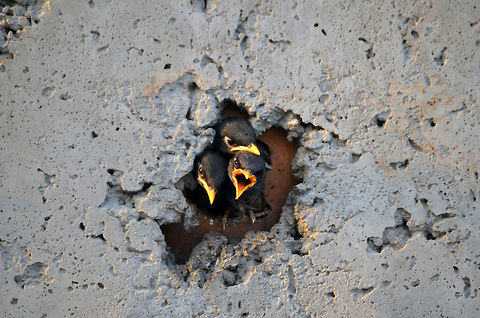
Appearance
The common myna is readily identified by the brown body, black hooded head and the bare yellow patch behind the eye. The bill and legs are bright yellow. There is a white patch on the outer primaries and the wing lining on the underside is white. The sexes are similar and birds are usually seen in pairs.The common myna obeys Gloger's rule in that the birds from northwest India tend to be paler than their darker counterparts in South India.
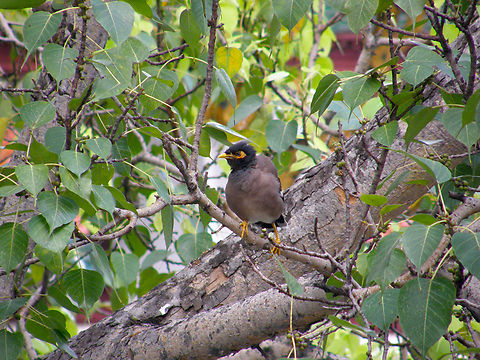
Naming
The etymology of the scientific name is as follows:⤷ "Acridotheres": Greek "akris", "akrodos", a locust; "theres", a hunter.
⤷ "tristis": Latin "tristis", sad, gloomy; Modern Latin "tristis", dull-coloured).The common myna has two subspecies:
⤷ "Acridotheres tristis tristis". Widespread, including Sri Lanka.
⤷ "A. t. melanosternus" Legge, 1879. Endemic to Sri Lanka.
The subspecies "melanosternus" is darker than the nominate subspecies, has half-black and half-white primary coverts and has a larger yellow cheek-patch. The type locality of the nominate subspecies is Puducherry, India.The IUCN declared this myna as one of the only three birds among the world's 100 worst invasive species.
It has been introduced widely elsewhere, including adjacent areas in Southeast Asia, Madagascar, the Middle East, South Africa, Madagascar, Israel, North America, Europe, Australia, New Zealand and various oceanic islands in the Indian and Pacific Oceans, including prominent populations in Fiji and Hawaii.
The common myna is a pest in South Africa, North America, the Middle East, Australia, New Zealand and many Pacific islands. It is particularly problematic in Australia. Several methods have been tried to control the bird's numbers and protect native species.
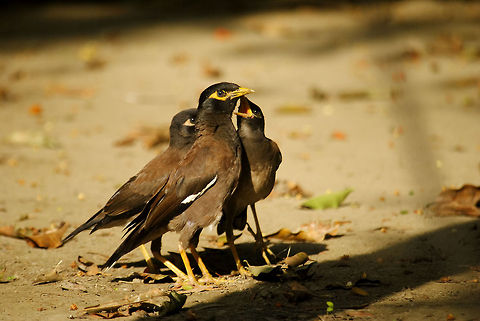
Distribution
It is a species of bird native to Asia with its initial home range spanning from Iran, Pakistan, India, Nepal, Bhutan, Bangladesh and Sri Lanka; as well as Afghanistan, Tajikistan, Turkmenistan, Myanmar, to Malaysia, Singapore, peninsular Thailand, Indo-China and China.The myna has been introduced in many other parts of the world such as Canada, Australia, Israel, New Zealand, New Caledonia, Hawaii, South Africa, Kazakhstan, Kyrgyzstan, Uzbekistan and islands in the Indian Ocean and also in islands of the Atlantic and Pacific Oceans. The range of the common myna is increasing to the extent that in 2000 the IUCN Species Survival Commission declared it among the World's 100 worst invasive species.
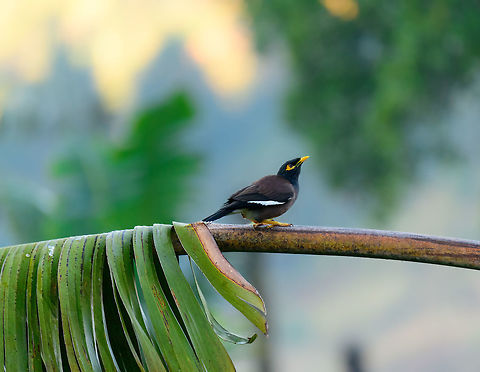
Behavior
Common mynas roost communally throughout the year, either in pure or mixed flocks with jungle mynas, rosy starlings, house crows, jungle crows, cattle egrets and rose-ringed parakeets and other birds. The roost population can range from less than one hundred to thousands. The time of arrival of mynas at the roost starts before and ends just after sunset. The mynas depart before sunrise. The time and timespan of arrival and departure, time taken for final settlement at the roost, duration of communal sleep, flock size and population vary seasonally.The function of communal roosting is to synchronise various social activities, avoid predators, exchange information about food sources.
Communal displays consist of aerial maneuvers which are exhibited in the pre-breeding season. It is assumed that this behaviour is related to pair formation.
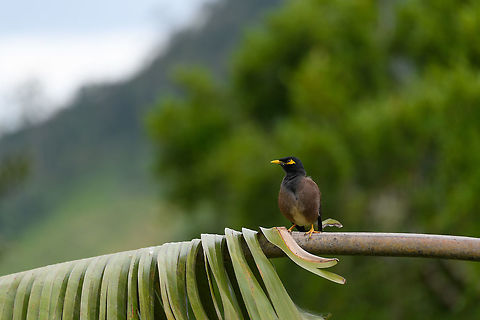
Habitat
This abundant passerine is typically found in open woodland, cultivation and around habitation. Although this is an adaptable species, its population has been decreasing significantly in Singapore and Malaysia due to competition with its cousin, the introduced Javan myna.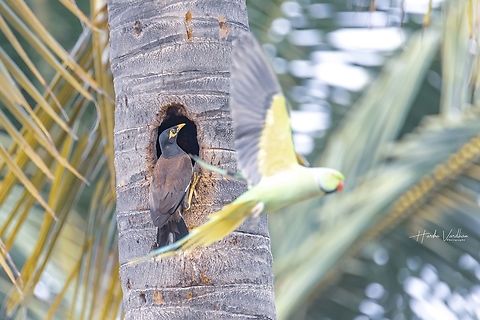
Reproduction
Common mynas are believed to pair for life. They breed through much of the year depending on the location, building their nest in a hole in a tree or wall. They breed from sea-level to 3000 m in the Himalayas.The normal clutch size is 4–6 eggs. The average size of the egg is 30.8 x 21.99 mm. The incubation period is 17 to 18 days and fledging period is 22 to 24 days. The Asian koel is sometimes brood parasitic on this species. Nesting material used by mynas include twigs, roots, tow and rubbish. Mynas have been known to use tissue paper, tin foil and sloughed off snake-skin.
During the breeding season, the daytime activity-time budget of common myna in Pune in April to June 1978 has been recorded to comprise the following: nesting activity, scanning the environment, locomotion, feeding, vocalisation and preening-related activities, interactions and other activities.
The common myna uses the nests of woodpeckers, parakeets, etc. and easily takes to nest boxes; it has been recorded evicting the chicks of previously nesting pairs by holding them in the beak and later sometimes not even using the emptied nest boxes. This aggressive behaviour contributes to its success as an invasive species.
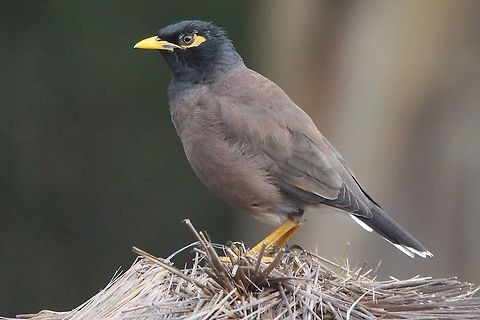
Food
Like most starlings, the common myna is omnivorous. It feeds on insects, arachnids, crustaceans, reptiles, small mammals, seeds, grain and fruits and discarded waste from human habitation. It forages on the ground among grass for insects, and especially for grasshoppers, from which it gets the generic name "Acridotheres", "grasshopper hunter". It however feeds on a wide range of insects, mostly picked from the ground. It is a cross-pollinator of flowers such as Salmalia and Erythrina. It walks on the ground with occasional hops and is an opportunistic feeder on the insects disturbed by grazing cattle as well as fired grass fields.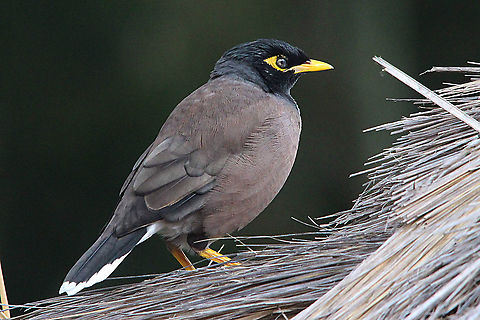
Defense
Common mynas roost communally throughout the year, either in pure or mixed flocks with jungle mynas, rosy starlings, house crows, jungle crows, cattle egrets and rose-ringed parakeets and other birds. The roost population can range from less than one hundred to thousands. The time of arrival of mynas at the roost starts before and ends just after sunset. The mynas depart before sunrise. The time and timespan of arrival and departure, time taken for final settlement at the roost, duration of communal sleep, flock size and population vary seasonally.The function of communal roosting is to synchronise various social activities, avoid predators, exchange information about food sources.
Communal displays consist of aerial maneuvers which are exhibited in the pre-breeding season. It is assumed that this behaviour is related to pair formation.
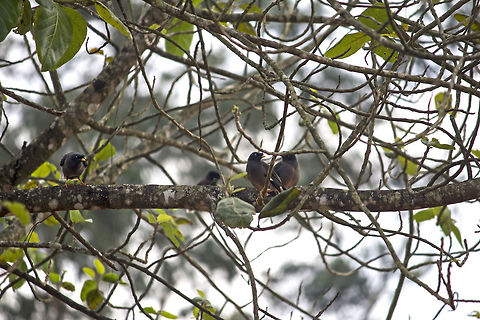
Cultural
The common myna widely appears under the name "saarika" in Indian culture from Vedic times, featuring both in classical Indian literature as well as in Prakrit Buddhist texts. The Sankrit term "shuksarika", which refers to the rose-ringed parakeet and the common myna, is used to indicate a pair or a couple, probably because both birds are vocal and capable of mimicking human sound.In Sanskrit literature, the common myna has a number of names, most are descriptive of the appearance or behaviour of the bird. In addition to "saarika", the names for the common myna include "kalahapriya", which means "one who is fond of arguments" referring to the quarrelsome nature of this bird; "chitranetra", meaning "picturesque eyes"; "peetanetra" and "peetapaad".
References:
Some text fragments are auto parsed from Wikipedia.